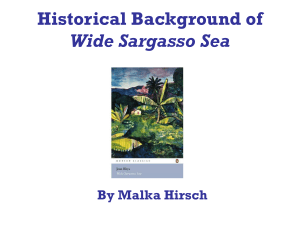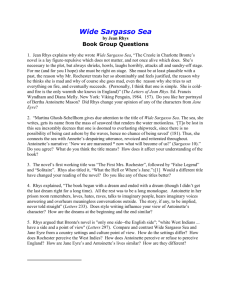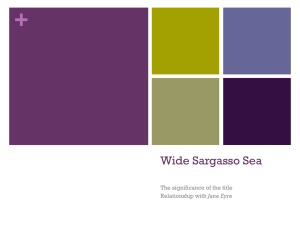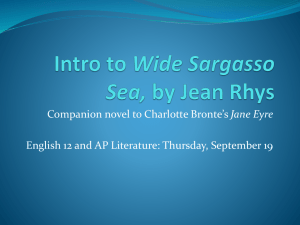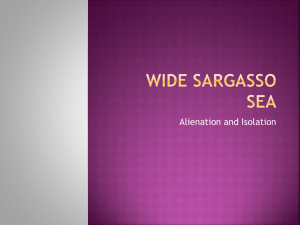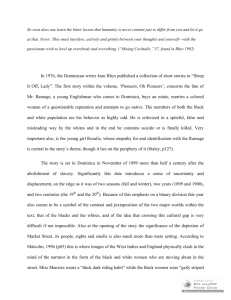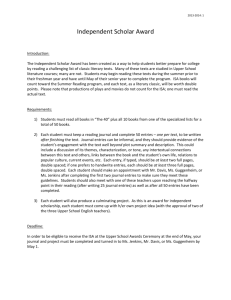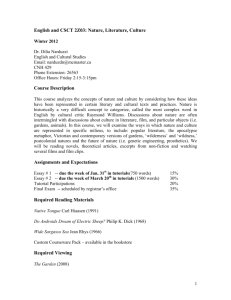'… Her skin was darker, her lips thicker than I had thought.'
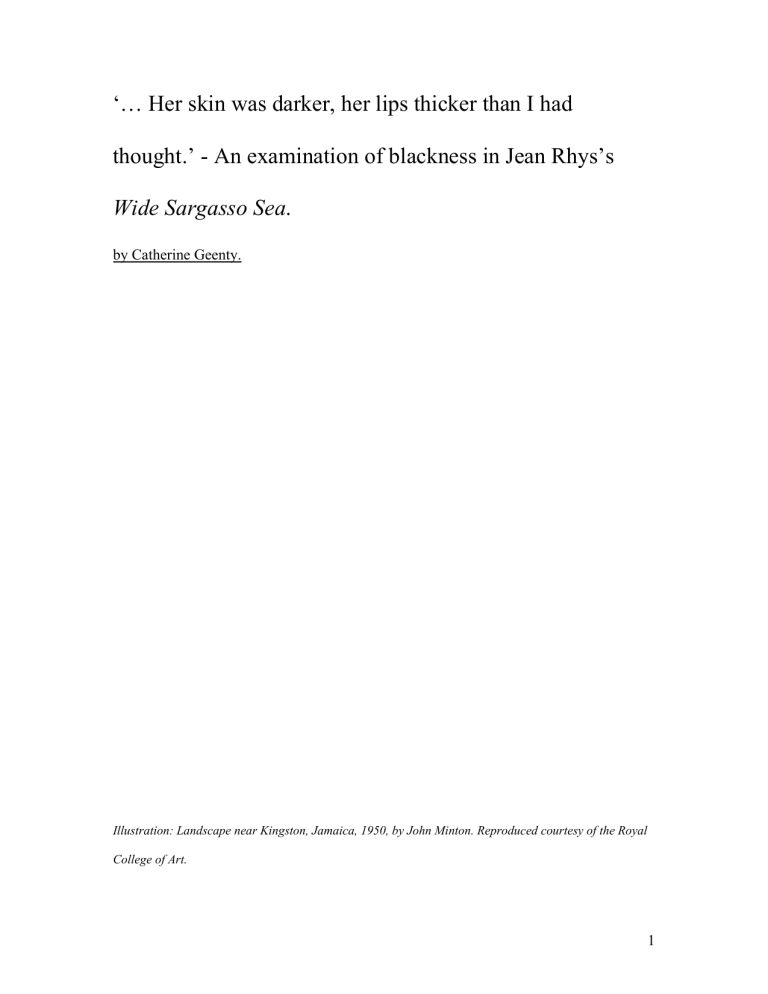
‘… Her skin was darker, her lips thicker than I had thought.’ - An examination of blackness in Jean Rhys’s
Wide Sargasso Sea.
by Catherine Geenty.
Illustration: Landscape near Kingston, Jamaica, 1950, by John Minton. Reproduced courtesy of the Royal
College of Art.
1
Generally, The Empire Writes Back suggests there is a common practice in literature emerging from the shadow of colonialism to ‘write back’ against a white literary canon. In the case of Wide Sargasso Sea, by Jean Rhys, A. Hanlin suggests that there is also a writing back against a master narrative that is both racial and patriarchal.
The re-telling of a story from a different point of view, argues Hanlin, is an extension of the deconstructive project of exploring the silences and omissions within a text. (Hanlin,
Postcolonial Discourse in Wide Sargasso Sea, p.1)
Jean Rhys’s Wide Sargasso Sea is an example of this ‘tradition’, a novel that was clearly written as a corrective text to Charlotte Bronte’s Jane Eyre. Writing, and printed media in general, has long been viewed as one of the strongest forms of cultural control.
Prior to any form of rewriting the master culture, we have seen a ‘take-over’ of oral and suppressed cultures by literature. With this in mind, it becomes evident that the rewriting of colonial narratives is an act of liberation for those who belong to the former colonies.
While the clear postcolonial textual liberation occurs when the black slave appropriates the media of the master culture to express a counter-history, Rhys’s novel takes on the more complex task of ‘coming to terms with European perceptions of the
Caribbean Creole community.’ (Hanlin, Postcolonial Discourse in Wide Sargasso Sea’, p.3) That is, Wide Sargasso Sea is Rhys’s own [personal] exploration of what it means to be of Caribbean descent, and how the European master culture views you, culturally and socially, as a result.
However, Wide Sargasso Sea only relates half of the story, that which comes from the white perspective. Just as Rhys believed Bronte’s Jane Eyre to be ‘only one side
– the English side’ of the story, so I believe that Wide Sargasso Sea represents a limited
2
perspective of life. (Smith, p.xvi) Whether Creole or British, the voices of the central characters are those of white people only. Whilst critiquing patriarchal and colonial discourse, Rhys has effectively backgrounded and exoticised the black Caribbean people in Wide Sargasso Sea. This essay will explore the way in which Rhys deploys the black
Carib women in her novels, taking into account a study of Rhys’s own background, her social and cultural position as a white Creole woman, and what impact this would have had on her writing.
Writing as a white Creole woman, Jean Rhys represents black women as necessarily ‘free’, liberated, and even occasionally tyrannical, in Wide Sargasso Sea.
Legally, black Caribbean people were freed from colonial rule with the introduction of the Emancipation Act of 1833, with full liberty being granted in August 1838. (Eric
Williams, cited in Smith, p.134) Rhys’s novel is set just after the emancipation of the slaves, in that uneasy time when racial relations in the Caribbean were at their most strained. The anxieties of the local white and mixed race population are played out in new modes of representing black islanders.
Black women were also typically thought of as having more personal freedom than their white counterparts. This is true to a certain extent, taking into account the strict restraints placed on women in Victorian England, in matters of what they could wear, who they were allowed to associate with, and the inevitability of their eventually being married off to start families of their own, at which stage they would pass from the control of their father into the dominion of their husbands.
After emancipation, black women were technically free from ownership, in a way that many white women of the time were not. Not suffering under any of the typical
3
constraints placed on women of the time, black women were not usually forced into marriage against their will, and were allowed a degree of sexual freedom that white
British women could only dream of. (Thomas, ‘The labyrinths of a “Savage Person”, p.152) In her autobiography, Rhys muses that ‘marriage didn’t seem a duty for them
[Dominican women] as it was with us,’ and that black women have ‘more freedom, particularly sexual, than the white islanders who must conform to the constraints of the colonist.’ (Rhys, cited in Thomas, “An Antillean Voice”, p.101)
Antoinette’s only childhood friend, Tia, is presented as an extremely liberated
‘free spirit’ in Rhys’s novel. Right at the start of the novel, the reader learns that Tia has skills to be envied; ‘fires always lit for her, sharp stone did not hurt her bare feet, I never saw her cry.’ (Rhys, Wide Sargasso Sea, p.9) Spatially, Tia is represented as free in Wide
Sargasso Sea; she has the freedom to go where she pleases, and do whatever she wants.
In contrast, Antoinette feels inhibited by her own inability to leave Jamaica, or, eventually, to leave Rochester. This idealisation of Tia is quite possibly, in part, a reflection of Antoinette/Rhys’s own longing to be just like her.
Another point to consider is that Tia is free because, knowing no other life, she has no sense of being ‘marooned’. If we look at the Caribbean context, the word
‘Maroon’ was the pre-emancipation term given to a runaway slave. If slaves were skilled and lucky enough to escape the plantation of their owner and not get caught, they were, for all intents and purposes, free. Thus the therm ‘marooned’, for Tia, exudes a sense of rebellion and liberation. Conversely, in regards to Antoinette and her mother, the term has entirely different connotations. Traditionally, marooned sailors were punished, isolated people, abandoned by the rest of their crewmates and left to die. In this sense,
4
Antoinette and Annette are marooned, castaways on the old estate of Coulibri, and have been actively abandoned there.
Similarly, the black serving girl Amelie is portrayed as both morally and economically liberated. Her lack of moral constraint allows her sexual encounter with
Rochester to take place. Afterwards, all Rochester can recall is her free and light-hearted manner: ‘She was so gay, so natural…’ (Rhys, Wide Sargasso Sea, p.89) This necessary association between blackness and nature/being natural pervades Wide Sargasso Sea.
Amelie becomes a part of the Jamaican landscape, as beautiful as foreign to Rochester as some exotic bird.
In addition to this, Amelie is much more economically liberated than the other female characters in the novel. She knows exactly what she wants to achieve with her life, and how to go about it, and is aware that she requires large amounts of money to do so. Her liaison with Rochester is the means for her to acquire this sort of sum:
‘I told her that I was leaving the island soon but that before I left I wanted to give her a present. It was a large present but she took it with no thanks and no expression on her face. When I asked her what she meant to do she said, ‘It’s a long time I know what I want to do and I know I don’t get it
Amelie is able to fulfil her life’s dream of working as a dressmaker with her sister in
Demerara, and then travelling to Rio, where all the rich men live. In sharp contrast to this, the reader is aware of Antoinette’s extreme poverty, and her financial inability to go anywhere without her husband’s consent.
5
Perhaps one of the most important and liberated characters in Wide Sargasso Sea is Christophine. Culturally accorded respect by almost all of the other characters,
Christophine’s position as a Martinique obeah woman grants her rank and status, not only with the black characters of the novel. Local girls are terrified of her, work for her for free, and even bring presents unasked for. The fearless Amelie is cowed into submission when threatened by Christophine’s obeah powers:
‘ “Amelie. Smile like that once more, just once more, and I mash your face like I mash plantain… I give you bellyache like you never see bellyache… Perhaps you don’t get up again with the bellyache I give you.
So keep yourself quiet and decent. You hear me?”
“Yes, Christophine,” Amelie said and crept out of the room.’
(Rhys, Wide Sargasso Sea, p.64)
Even the white Creoles accord Christophine with respect, and some fear. Antoinette’s mother, Annette, warns her daughter of the level of respect she ought to grant to
Christophine, stating firmly ‘I dare say we would have died if she’d turned against us…’
(p.8) Similarly, the other white women in the neighbourhood stand in awe of
Christophine, and her obeah magic. One lady even goes so far as to mockingly accredit
Coulibri’s luck in being taken under Mason’s wing to black magic:
‘… one unfortunate loss is always a clever man’s gain. No, the whole thing is a mystery. It’s evidently useful to keep a Martinique obeah woman on the premises.’ She said it mockingly, not meaning it, but soon other people were saying it – and meaning it.
(Rhys, Wide Sargasso Sea, p.8)
6
Additionally, the reader is given the sense of Christophine’s freedom as a personality. Her personal life asserts her deliberate difference from the white people around her, particularly Rochester. This freedom is also reflected in her ability to come and go as she pleases, despite her initial position as a worker in the Coulibri household.
Annette tells her daughter that Christophine was a wedding gift from her husband, who thought she ‘would be pleased with a Martinique girl.’ (Rhys, Wide Sargasso Sea, p.8)
However, this is immediately followed by the statement that Christophine has only remained in relative servitude all these years because she wished to; ‘Christophine stayed with me because she wanted to stay. She had her own very good reasons you may be sure.’ (p.8) Once again, the stark contrast between Christophine’s freedom of movement and Antoinette and Annette’s enforced stasis is marked.
Finally, Christophine is even granted certain freedom from traditional systems of justice. Unlike Antoinette, Christophine is able to confront Rochester with her awareness of the hypocrisy of his so-called ‘justice.’ When, in response, he threatens her with the law, she answers:
‘No police here… No chain gang, no tread machine, no dark jail either.
This is free country and I am free woman.’
(Rhys, Wide Sargasso Sea, p.103)
In doing so, according to Smith, in her notes on the text, Christophine is able to do to
Rochester what Antoinette cannot, and ‘[dismantle] his coded message of imperial power.’ (Smith, p..xix)
In contrast to her portrayal of many ‘liberated’ black women, Rhys represents her white Creole characters as victims or prisoners. This is most clearly evident in Wide
7
Sargasso Sea, where Antoinette’s personal repression is made all the more evident through the black ‘free spirits’ that inhabit the pages of the novel. Rhys deploys the black women of her novel in such a way that highlights Antoinette’s lack of freedom, and in this way the black characters in Wide Sargasso Sea are effectively manipulated in order to better express the white Creole perspective and isolation.
Antoinette’s fight with Tia at the river is an example of this tendency in Rhys’s work. Tia’s taunting words, and her subsequent theft of Antoinette’s clothes, emphasise the feelings of loneliness and isolation experienced by Antoinette throughout the course of the novel. Her unconditional longing to be just like Tia is thwarted by Tia’s hostile behaviour towards her:
‘That’s not what she hear, she said. She hear all we poor like beggar. We ate salt fish – no money for fresh fish. That old house so leaky, you run with calabash to catch water when it rain. Plenty white people in Jamaica.
Real white people, they got gold money…’
(Rhys, Wide Sargasso Sea, p.19)
This memory is followed closely by the burning of Coulibri, on which night the gap between Antoinette and Tia becomes impassable:
‘Then, not so far off, I saw Tia and her mother and I ran to her, for she was all that was left of my life as it had been. We had eaten the same food, slept side by side, bathed in the same river. As I ran, I thought, I will live with Tia and I will be like her… When I was close I saw the jagged stone in her hand but I did not see her throw it. I did not feel it either, only something wet, running down my face...’
8
(Rhys, Wide Sargasso Sea, p.24)
According to Smith, Tia can be seen as an image of possible healing for
Antoinette’s sense of fragmentation, in the scene of changing dresses. The doubling signals disruption rather than completion, as Tia acts as part of the mob which burns
Coulibri, and Antoinette’s violation by and severance from Tia are signified in the blood coming from the cut on her head. (Smith, p.xx)
It is significant to note that Anoinette’s displacement is the novel is expressed in terms of negatives. She is not black, but she is not white either. Similarly, her longing is expressed also in negatives: ‘not to leave Coulibri, not to go.’ (p.24) With this in mind, it is really only through her interaction with Tia that Antoinette comes to realise how radically out of place she is among the black people of Jamaica, and how futile her wish to become one of them truly is.
West Indian spirituality, and the threat of ‘black magic’ are also credited with much of the blame for Antoinette’s isolation and fear as a child. Right at the start of the novel, Antoinette speaks of Coulibri being ‘changed’, ruined for her, by talk of
Christophine and her obeah. Antoinette’s account of a spiritual encounter that took place in Christophine’s bedroom encapsulates her early childhood fears of obeah and black magic:
‘I was certain that hidden in the room… there was a dead man’s dried hand, white chicken feathers, a cock with its throat cut, dying slowly, slowly. Drop by drop the blood was falling into a red basin…’
(Rhys, Wide Sargasso Sea, p.15)
9
Antoinette’s fears are crystallised in this one memory, fears of black power, both literally and figuratively. As a white Creole, she has reason to fear the ex-slaves who live near the plantation, and it seems no coincidence that this account is closely followed by her memory of the burning of Coulibri. childhood nurse, Maillotte, are singularly condemning, citing her influence as the cause for many negative aspects of her [Anna’s] life. Initially in awe of Maillotte’s beauty and exotic charm, Anna yearns to be ‘just like her’, automatically associating her with the freedom and beauty of her native Caribbean home. However, her resultant shock and disgust on learning of Maillotte’s seemingly disturbing obeah practices seems to scar
Anna for life:
‘The sins of the father… are visited upon the children unto the third and fourth generation – don’t talk such nonsense to the child Father said – a myth don’t get tangled up in myths he said to me.’
(Rhys, Voyage in the Dark, p.46)
Yet another black character in Voyage in the Dark, Black Pappy is also credited with instilling fear into the young Anna at a very early age:
‘He would bawl out at you that you mustn’t trail your hand in the water on account of the barracoutas. Then you would imagine the barracoutas – hundreds of them – swimming by the side of the boat, waiting to snap.’
(Rhys, Voyage in the Dark, p.46)
In order to interpret Rhys’s ambivalent attitude towards coloured Caribbean women, it is necessary to examine her own autobiographical accounts of her life experiences. In
10
her essay ‘The White Creole Woman’s Place in Society’, Martina Ghosh-Schellhorn cites
Rhys’s own personal diary, where she writes of her own experiences with coloured people as a child. Her memories of her childhood nurse Meta are singularly negative and menacing; in her diary, Rhys blames Meta for instilling into her a fear of ‘zombies, soucriants and loup-garous.’ (Ghosh-Schellhorn, p.185) Similarly, in her autobiography
Rhys writes once more of the long-lasting negative influence of her evil black nurse, who
“had shown me a world of fear and distrust, and I am still in that world.” (Ghosh-
Schellhorn, p.185)
Similarly, the problematic nature of a white Creole existence is emphasised right at the start of the novel, in Antoinette’s explanation of her lonely, isolated existence:
‘They say when trouble comes, close ranks. And so the white people did. But we were not in their ranks.' (Rhys, Wide Sargasso Sea, p.5).
This introduction to Wide Sargasso Sea gives the reader a strong sense of a lack of belonging, mirrored in Rhys’s own life.
With the abolition of slave ownership in the 1830’s, plantation owners were suddenly and unexpectedly disadvantaged. As well as having lost the ‘right’ to free labour on their plantations, sugar prices halved, in response to the introduction of free trade. The planters were abruptly toppled from their privileged trading position, and although there was
‘compensation’ for slave owners, much of it went to the plantation owners’ creditors, and not to them. In addition to this, most sugar estates in the West Indies were already heavily mortgaged. (Eric Williams, cited in Smith, p.134)
The white Creoles were at a strong disadvantage to incoming businessmen to the
West Indies, such as Mason, with his ‘new money.’ Dispossessed by a new wave of
11
colonisers, many old slave-owning families were left with no money. (Eric Williams, cited in Smith, p.134) Rhys, and, correspondingly, Antoinette, were both in this position, marooned in the West Indies, and left almost completely destitute by the Emancipation
Act. With this in mind, it is not surprising that Rhys would have harboured strong resentment of the black people of Dominica, whom she quite possibly would have seen as almost solely responsible for her family’s downfall.
In addition to her economical history, it is necessary to examine Rhys’s actual social position as a white Creole. Ghosh-Schellhorn explores the notion of Creole transitional identity, a concept that encompasses ‘both the colonised and those who belong racially to the colonisers’ site of power, yet are not regarded as equal within the dominating order.’
Rosemary Moore writes on this subject:
…for a white woman to sympathise at this time with those outside her own racial group was to be a traitor to her own kind and thus to become alienated from them. And for someone brought up on the myth of British superiority it was natural to have sympathies in common with indigenous people similarly placed outside the dominant system. However, if white colonials were taught to think of Britain as home, they were treated as outsiders when they got to Britain. Thus Rhys was an outsider in both societies to which she naturally belonged and the ambiguity that arises from being both of and not of England and Dominica shapers her
With this in mind, Rhys’s social position as a white Creole woman can be likened to a permanent state of shipwreck, echoed by Bertha’s repeated cry “We are marooned!”
12
Ghosh-Schellhorn argues that Rhys’s own life mirrors the Caribbean history of European conquest and desertion, and the resultant dependence of the colonised on the coloniser.
(Ghosh-Schellhorn, p.181)
Ghosh-Schellhorn also explores the double-bind of being both coloniser and colonised and not belonging within either society, of having to choose to be either a
‘white cockroach or a white nigger.’ (Ghosh-Schellhorn, p.183) Rhys’s social position as a white Caribbean, caught between loyalties to her country of birth and her ‘intellectual homeland’, challenges JanMohamed’s Manichean allegory for colonialism, in that Rhys does not fall directly into either category, she is not entirely coloniser or colonised.
(Ghosh-Schellhorn, p.183)
Despite the many strong and compelling arguments made exploring Rhys’s personal isolation and oppression, her marginalisation as a white Creole, and how has come to reflected in her work, I cannot overlook completely her deployment of black female characters in her novels. In her novels, Rhys explores at great length of the identity crisis experienced by both the white Creoles and the coloniser returning to the colonised nation.
However, absolutely no mention is made of those characters who have been truly dispossessed of identity and agency. Specifically, Antoinette’s search for belonging, her feelings of ‘placelessness’, are privileged over those of the coloured Creoles of Wide
Sargasso Sea.
Most importantly, the supposed freedom by which the black women in Rhys’s novels are characterised is, in essence, a myth. When the Emancipation Act was passed in the
West Indies, the British Government made no move to offer compensation to the millions of black people whose lives had effectively been ruined by slavery. Instead, the
13
Government awarded ex-slave-owners a compensation of £19 per slave. (Eric Williams, cited in Smith, p.133) In her essay ‘Women must have spunks’, Lucy Wilson quotes
Douglas Hall on the abolition of slavery:
After August 1, 1838, all were equal citizens – in the eyes of the law. But not all were equal citizens in the eyes of society or in the eyes of those who were the makers and administrators of the law… Slavery as a legal institution had gone; but the society shaped by slavery remained with its criteria of whiteness, wealth and education. (Douglas Hall, cited in
Wilson, p.72)
Similarly, despite Rhys’s envy of black women who do not have to marry, and who have such extreme sexual freedom, it cannot justly be said that black women were any more free and liberated than their white Creole counterparts. The fact that they were not forced to marry, were able to become sexually involved with men with apparently no compunction, and did not feel the need to cover themselves up with clothing, does not constitute freedom. Instead, black Caribbean women had even less freedom than their white counterparts, mainly for the above reasons. Rather than, or as well as, being a cause for envy, such ‘freedoms’ as were attributed to black women worked simply to malign them in the eyes of the rest of society. It is inevitable that the false ‘spirit’ of freedom attributed to black women resulted in them typically being stereotyped as having loose morals and no sense of ‘civility’ or what constituted ‘good behaviour’. No longer ‘free spirits’, they were more accurately seen by white society as ‘savages.’
With this reality of oppression of black Caribbean people taken into account, the supposed relationship that exists between blackness and freedom is false, and
14
marginalizes Creole women by trivialising and/or ignoring their experiences and their turbulent history. When one considers the double marginalisation of Creole women, the need to question acculturated models becomes evident. In the case of Rhys’s novel, this leads to the question of whom the story belongs to, who, if anyone, is controlling the master narrative.
The focus of Wide Sargasso Sea lies on the conflict between Antoinette and
Rochester, his treatment of her, and her resulting descent into madness. Judie Newman speaks of the co-dependant coloniser/colonised relationship that exists between
Antoinette and Rochester. However, no examination of the truly colonised/marginalised characters is made within the novel. Where do Christophine, Tia and Amelie fall within this coloniser/colonised relationship? It seems questionable that any of these figures can be seen in any real role of power.
In her work The Ballistic Bard, Judie Newman briefly mentions Christophine’s curse of blindness on Rochester, interpreting this as Rhys’s reversal of the current of determinism of Jane Eyre, her way of making the action of Bronte’s novel the result of an obeah curse. Here, I would once again point out that, whilst Christophine may be one of the only characters in the novel able to speak their mind to Rochester, she is still portrayed, through Rochester’s eyes, as a figure of ridicule, a ‘stupid old woman.’
Christophine’s speech is a broken jumble, half-English, half-Patois, and when she is in conversation with Rochester, her voice is constantly interrupted by his thoughts, which mimic her words and override them. (Newman, p.100) Rochester even goes so far as to break into Christophine’s speech and imitate her way of speaking:
‘I don’t meddle in that for béké. I tell her its foolishness.’
15
(Foolishness, Foolishness.)
‘And even if it’s no foolishness, it’s too strong for béké.’
(Too strong for béké. Too strong.)
(Rhys, Wide Sargasso Sea, p.99)
Although Rhys may have given Christophine a voice, it is not one vested with any real authority.
Finally, Newman construes Antoinette’s jump as a final revolt against slavery, stating that this action aligns her with the West Indies. She cites an example of a dreamdeath of Carib legend; in this way, she argues, Antoinette is not simply dying but rather fleeing into a West Indian heaven/paradise. I find this point of Newman’s argument less contentious than those discussed above. It is my opinion that Antoinette/Rhys could never have fully attained the imagined ‘freedom’ of the coloured Carib woman, and that it is only through death that Antoinette and Tia can finally be unified. However, this longing of both Antoinette and Rhys to gain a sense of belonging within a culture they do not fully understand, nor make any real attempt to understand, once again backgrounds and marginalizes the coloured characters of the novel.
In her essay ‘Migratory Subjectivities’, Carol Davies states that cultural theorising tends to be most commonly carried out by those with the power to ‘disseminate’, in most cases the white male figure. Subsequently, the way in which women of colour theorise themselves often falls outside of the boundaries of academia. (Davies, p.999) Perhaps as a direct result of this, coloured women are almost always written for, rather than given their own mode of self-expression.
16
For many theorists, all women are seen as unreliable speakers, with no authority to relate their life experience; however, this degenerative opinion is most evident in relation to coloured women. The subaltern woman is inevitably spoken for in Western literature, positioned in silence. Writing, as a form of expression, permits control, of the word, of identity, and of information; for a woman of colour living under colonial rule, control is significantly absent in these areas. Thus it is not simply the power to write that is being denied these women, but rather any sort of control over their own existence.
The fact that no real ‘alternative voices’ are presented in Wide Sargasso Sea seems to me highly problematic. Those permitted speech for themselves are white characters only.
This lack of voice, and thus agency, for black women is evident in much of Jean Rhys’s work, in the coloured figures that permeate her novels about the Caribbean. The figure of
Christophine is of particular concern to me, in Rhys’s Wide Sargasso Sea. Despite both
Antoinette and Rhys’s instance that Christophine is her own mistress, I find her supposed
‘freedom’ to act and speak within the novel to be a problem. Christophine is exiled in
Wide Sargasso Sea, both in terms of the plot, and the actual construction of the novel.
She is forced to inhabit the margins of the story, and it is left up to both Antoinette and the reader to seek her out for themselves. The role she plays in the development of the novel’s action is significant, however its significance is glossed over by Rhys. Her final speech at the end of the novel is undercut by Rochester and his mockery of her.
With this in mind, it is my opinion that, in order to better understand the role and deployment of black women within Wide Sargasso Sea, the character of Christophine needs to be examined more closely. In her essay ‘From Antoinette to Bertha: the process
17
of 'colonising' within the marriage in Rhys’s Wide Sargasso Sea’, Hanlin labels
Christophine as a site of alternative power.
Once again, I find such a statement to be contentious. This ‘power’ can only ever really be used and drawn upon by Antoinette; we never see Christophine use her obeah powers for herself, only to aid Antoinette and her mother. Hanlin similarly states that
Christophine can be recognised as ‘the holder of judicial authority’ within Wide Sargasso
Sea. (Hanlin, ‘From Antoinette to Bertha’, p.12) I cannot see any true authority being granted to Christophine; she is ultimately powerless to save Antoinette, and is forced to bow to Rochester’s authority as Antoinette’s husband and keeper. Wilson supports this line of argument, stating that, because she is black, poor and wanted by the police,
‘Christophine is as powerless to change the tragic course of Antoinette’s life as she is to redress social and political injustice in 19 th
century Jamaica.’ (Wilson, p.73)
In her essay ‘An Antillean Voice’, Thomas explores the figure of the black nursemaid both in Rhys’s novels and in her autobiography. Described as having a
‘curiosity about, a fascination, a near obsession with them [African Caribbean people]’,
Rhys’s literary reflections on racial difference in Dominica are labelled as ‘thinness of thought’, and having ‘no complex historical vision.’ (Thomas, ‘An Antillean Voice’, p.95) Rhys’s relationships with black females are ambivalent throughout her writing, presented in terms of dualisms. This is particularly clear in Voyage in the Dark, with the doubling of two black female servants, one alluring, the other destructive.
Similarly, there is a strong demonic doubling of several key black figures in
Rhys’s autobiography. Meta, her nurse, who ‘never smiles and always seems to be muttering curses,’ is the ‘bedevilled double’ of Francine, the black cook at Rhys’s early
18
childhood home Bona Vista. According to Rhys, Francine’s stories were ‘quite different, full of jokes and laughter, descriptions of beautiful dresses and good things to eat.’ Meta, on the other hand, was seen as responsible for all the negative events in Rhys’s life, and
Rhys recalls shouting at her on several occasions, naming her ‘Black Devil!’ (Rhys, cited in Thomas, ‘An Antillean Voice’, p.98-9) This doubling replicates the good/bad dichotomy found in many colonial narratives, in regards to black people, and Rhys effectively perpetuates this doubling in nearly all of her writing.
Following the same line of thought, Ghosh-Schellhorn identifies Christophine as a composite of the two types of ‘blackness’ known to Rhys; the ‘good’ black woman or nursemaid, and the menacing obeah woman, ‘whose negative influence placed Rhys in a world of fear and distrust.’ (Ghosh-Schellhorn, p.185) Once again, this extreme simplification of the coloured women within Rhys’s novels is highly problematic.
Similarly, later in the novel Antoinette comes to see Christophine as an ‘ignorant, obstinate old Negro woman,’ (p.93), rather than the epitome of kindness and love she once portrayed. The ties connecting Antoinette with Christophine are threatened by “the white Creole compulsion to escape from a world believed to be hostile, in which she is, typically, utterly dependent for survival on the mediation of the loyal native informant.”
(Ghosh-Schellhorn, p.185) This negative portrayal of coloured Carib women perhaps reveals something of Rhys’s own fear, and possibly dislike, of such women. With this is mind, it follows that any characterisation of black women in Rhys’s novels will unavoidably be biased.
In her autobiographical notes, Rhys described herself as ‘wary’ of black people that she does not know well or know at all; they merge with the mob that ‘surround’ her.
19
(Rhys, cited in Thomas, ‘An Antillean Voice’, p.49) This inherent bias in Rhys effectively represses any effort in her to understand the power structures inherent in the relationships or the subjectivities of the women who are the objects of her desire. There is no truly ‘shared feeling of belonging and merging,’ in her longing to ‘become’ the black figures of her childhood. Rhys appears to have possessed a dual desire for, and fear of, blackness. (Thomas, ‘An Antillean Voice’, p.51)
Rhys’s desire for blackness is most clearly enacted in the love/hate relationship that exists between Tia and Antoinette in Wide Sargasso Sea. Rhys notes in her autobiography that she once overheard her mother expressing a preference for black babies, and from that time forward viewed herself with ‘loathing of her white racial embodiment.’ Rhys then goes on to describe quite pitifully how she checked the mirror each morning for ‘the miracle transformation to blackness’ for which she so longed.
(Rhys, cited in Thomas, ‘An Antillean Voice’, p.100) With this in mind, in Wide
Sargasso Sea, Rhys transfers her own insatiable longing to become black onto
Antoinette, with her corresponding with to be just like her black friend Tia.
In her essay “Difference, intersubjectivity, and agency in the colonial and decolonising spaces of Helen Cixous’ ‘Sorties’,” Sue Thomas discusses the concept of cultural cross-dressing in literature as a ‘strategic sign of [the] ability to cross barriers of difference.’ (Thomas, “Difference, intersubjectivity, and agency,” p.9) Taking on the garments of another allows the individual a release from their own existence, ‘the promise of transgressive pleasure without any material penalties of actual change.’ This concept of cross-dressing is evident in Wide Sargasso Sea in the swapping of dresses that takes place between Antoinette and Tia. Antoinette’s longing to be just like Tia, to take
20
on her cultural identity is crystallised in this scene, with the re-dressing representing a form of release from her [Antoinette’s] own misery.
However, Thomas goes on to critique this idea, in that such cultural re-dressing does not contribute to the subversion of existing hierarchies of power; the cross-dresser can always simply ‘reveal or revert to her First World identity beneath the re-dressing of difference.’ (Thomas, “Difference, intersubjectivity, and agency,” p.9) Thus Antoinette’s longing for release comes without any understanding of the very real suffering of Tia, as a coloured Carib girl. It is important to note that Tia’s supposed freedom within Wide
Sargasso Sea masks the fact that she was obliged to play with Antoinette, and did not necessarily choose to do so of her own accord. When forced to wear Tia’s dress,
Antoinette feels ‘sick.. hating her [Tia]’, without realisation of what she said to make Tia steal her clothes (“you cheating nigger.”) Antoinette is able to change clothes upon reaching home, easily reverting back into her ‘First World’ identity.
Similarly, Thomas criticises Cixous’ inhabiting of African female space in order to contest Western psychoanalysis and philosophy, asking, “What kind of openness to colonial or decolonising difference inform her redressive inhabitings of African female space?” (Thomas, “Difference, intersubjectivity, and agency,” p.7) In the same way, by attempting to inhabit the space of a marginalised Creole woman, Rhys appropriates the historical resonance of certain significant events and symbols, such as colonisation, the abolition of slaving, and the violence and courage of those who struggled against such systems of control. Ultimately, according to Thomas, Rhys/Antoinette’s freedom can only be attained by the repression or occlusion of coloured Carib women, in colonial
21
space, through an ‘ideologically interested foreclosure.’ (Thomas, “Difference, intersubjectivity, and agency,” p.14)
This is particularly evident in Rhys’s work, and not only in Wide Sargasso Sea. After
leaving Mr MacKenzie reveals a similar backgrounding of racial oppression, in the story of Julia, her relationship with her black Caribbean mother, and her subsequent position as a half-caste living in England. Julia is constantly described as odd- and foreign-looking, with a distinctly Asiatic appearance: her ‘very thick dark hair’ that stands out ‘wildly round her head’, her slender, long-fingered hands ‘like the hands of an oriental.’ (p.11)
She is undeniably marginalised because of her nationality, both by the other characters in the novel, and by Rhys herself. The fact that Rhys has created Julia in the stereotypical image of the drunken, dissolute coloured woman reveals a strong racial bias on Rhys’s part.
Similarly, Rhys implies that Julia’s incredible lethargy is somehow a direct result of her ‘bad blood’, stating through Julia’s sister Norah: ‘there is something wrong with out family… we are lazy and soft.’ (p.45) This image of the half-caste or coloured woman as apathetic and indolent would appear to signal an undeniable prejudice in Rhys, through her preconceived notions of what constitutes a coloured woman’s ‘typical behaviour.’ It could perhaps be argued that the figure of Julia, and her constant loneliness and isolation, represent Rhys’s’ ultimate wish to fit into either of the two cultures she has been rejected by during her life. ‘It was not easy to guess at her age, her nationality, or the social background to which she properly belonged.’ (p.5): Julia exists in an amphibious state of being, not properly belonging to any cultural or social group. However, Julia’s ultimate
22
failure to fit in anywhere would imply that Rhys was not optimistic on this matter, or that she held deep-seated prejudices regarding half-castes despite being one herself.
However, the most contentious issue for me in After leaving Mr Mackenzie is Rhys’s complete trivialisation of Julia’s mother, who remains unnamed throughout the entire novel. A coloured woman from some unmentioned Caribbean island, Julia’s mother is portrayed as the ultimate burden. Not only is she paralysed after suffering stroke, she is utterly foreign within the novel. Thus, for Julia and Norah, the burden lies not only in looking after an invalid mother, but dealing with her embarrassing heritage. In my opinion, the mother is the most truly isolated character of the novel, literally and metaphorically paralysed, and completely static in time. However, her isolation pales in the face of Julia’s loneliness. Once again, Rhys’s refusal to see or accept to true situation of the coloured Carib women in her life is reflected in her novels.
This denial of the reality of oppression suffered by black women is probably most evident in the theme of amnesia and forgetfulness in Wide Sargasso Sea. Rhys’s novel plays host to many dark secrets that are only ever glimpsed by the reader, most of which have their roots in West Indian history, particularly the history of slavery in the area.
According to Smith, the inhabitants of the island all appear to collude in the concealment of their past. (Smith, p.xiv) Rochester’s enquiry into the naming of a village, Massacre, on their honeymoon is met by seeming vagueness on Antoinette’s part:
‘And who was massacred here? Slaves?’
‘Oh no.’ She sounded chocked. ‘Not slaves. Something must have happened a long time ago. Nobody remembers now.’
(Rhys, Wide Sargasso Sea, p.39)
23
In truth, the name of the village has oblique links with an actual historical event, the probable murder of a mixed race Indian. (Peter Hulme and Neil Whitehead, cited in
Smith, p.132)
This willed amnesia is found in both exploiters and exploited in Wide Sargasso
Sea. Both the descendants of plantations owners, like Antoinette, and ex-slaves, conspire to suppress any remaining record of the cruel reality of slavery in the West Indies.
(Smith, p.xv) Similarly, the transition from slavery to emancipation is fraught with forgetfulness and mystery in Wide Sargasso Sea. Speaking of the time surrounding the
Emancipation Act, Antoinette states that ‘Many dies in those days, both white and black… but no one speaks of those days now. They are forgotten.’ (p.40) However,
Smith argues that such past atrocities are clearly not forgotten within the text, but that memories have been wilfully suppressed out of guilt and shame. (Smith, p.xv)
Additionally, it is clear that, in Rhys’s work, this motif of intentional amnesia works on several levels. Whilst the characters of the novel may work to passively conceal their past, so too does Rhys openly ignore the horrific reality of slavery in the West
Indies. In almost all of her work, Rhys projects an image of the black subaltern woman as a liberated free spirit, consciously ignoring the violent and savage history of slavery.
Ultimately, the supposed freedom of the black characters in Rhys’s novels is shown to be an insubstantial illusion.
After having examined both Rhys’s writing and her own background, it cannot be denied that there are strong racist undertones to much of her work, however hidden they made be. Most specifically, in Wide Sargasso Sea, Antoinette uses much extremely racist language, referring in the early stages of the novel to the black mob as ‘animals howling.’
24
(p.20) Rhys/Antoinette seem to honestly fear and loathe many of the black characters of the novel, whereas the truly despicable white characters tend to be portrayed mildly or even indifferently.
There is a noticeable preoccupation with colour in Wide Sargasso Sea, specifically with gradations of blackness. According to Smith, this preoccupation with colour and
‘blackness’ was common, the novel being set in a period when there existed a ‘neurotic obsession with defining racial mixture.’ (Smith, p.133) Colour gradation was even charted in the nineteenth century, ranging from slightly coloured to extremely black: sambo, mulatto, quadroon, mustee, mustiphini, quintroon and octoroon were all markers used to define and categories coloured people, based on their level of ‘blackness.’
Anxiety about race and colour seems to permeate both Rhys and Antoinette’s consciousness. When her hair is cut off after a bout of fever, Antoinette is reassured that it will grow back again, to which she brusquely replies, ‘ “But darker.” ’ (p.24) In the same way, Rochester embodies this strong anxiety about race, particularly regarding his wife, thinking as he studies her face:
Creole of pure English descent she may be, but they are not English or European either.’ (Rhys, Wide Sargasso Sea, p.40)
Additionally, Rochester is revolted by the very thought that Antoinette may have ever had a sexual relationship with a black man. Such an act would, in his mind, have tainted her very being, making her unworthy of him.
This fear of miscegenation permeates the Wide Sargasso Sea, adding to the racist undertones. Even before he hears Daniel’s slanderous tale, Rochester has doubts about his wife, wondering at her decidedly un-English appearance, her ‘long, sad, dark alien
25
eyes.’ (p.40), despite Mason’s best efforts to purchase a husband for Antoinette to silence the innuendo surrounding her mother.
Similarly, Smith cites the example of Rochester’s night with Amelié, after which he notices that ‘her skin was darker, her lips thicker than I had thought.’ (p.89) Smith goes on to point out the ominous tone of this observation, as Rochester had initially been under the impression that Antoinette and Amelié resembled each other: ‘Perhaps they are related… It’s possible, it’s even very probable in this damned place.’ (p.81) Thus, in spite of Mason’s best efforts to conceal the family’s chequered history, the spectres of the past are re-awoken by Rochester, raising unspoken fears of incest and miscegenation. (Smith, p.xvi)
This then brings into question Rhys’s suitability, and perhaps capability, to write of personal oppression, as a white Caribbean woman. Although it cannot be denied that
Rhys suffered much personal oppression as a white Creole, I do not believe this gives her licence to bracket off the very real suffering of the black Creole people. By not allowing any of her black characters a real voice, Rhys effectively ignores them and their turbulent history of violation and cruelty. According to Thomas, the Other is inside the control of fantasy and projection. (Thomas, “Difference, intersubjectivity, and agency,” p.22) With this in mind, the ultimate other within Rhys’s work is undeniably the black other, idealised in WSS as liberated and empowered.
In her notes to Wide Sargasso Sea, Angela Smith mentions Antoinette’s view of herself as a ghost, ‘trapped in limbo and defined by negatives, a [woman] who eventually sees herself without recognition.’ (Smith, p.xx) However, although the reader my be encouraged to view Antoinette as a ghost-like wraith, I would argue instead that it is the
26
black characters who are the real ghosts that haunt Wide Sargasso Sea. Voiceless, powerless, and often nameless, these black women move wraith-like through the novel, never given the chance to express themselves or tell their own stories.
27
Bibliography:
•
•
Davies, C. (1998) “Migratory Subjectivities.” In J. Rivkin and M. Ryan (Eds.)
Literary Theory: An Anthology (pp.996-1015). Oxford: Blackwell Publishers
Inc.
Hanlin, A. (14 April 2003) “Postcolonial Discourse in Wide Sargasso Sea.”
Online discussion forum, accessed 15/1/04 via the World Wide Web: www.qub.ac.uk/english/imperial
•
Hanlin, A. (14 April 2003) “From Antoinette to Bertha: the process of
‘colonising’ within the marriage in Rhys’s Wide Sargasso Sea.” Online discussion forum, accessed 15/1/04 via the World Wide Web: www.qub.ac.uk/english/imperial
•
Hulme, P. and Whitehead, N. L. (1992) Wild Majesty: Encounters with Caribs
from Columbus to the Present Day, pp.89 ff. Oxford: Oxford University Press.
[Cited in Smith, A: Introduction and general notes to Wide Sargasso Sea.
London: Penguin Classics.]
28
•
•
Ghosh-Schellhorn, M. (1998) “The White Creole Woman’s Place in Society.”
In W. Klooss (Ed.) Across the Lines. (pp.177-190). Amsterdam: Rodopi.
Moore, R. (2001) “Gender, Race and Intertextuality in Wide Sargasso Sea.” In
D Schwedt, (Ed.) CRNLE Journal (pp. 94-104). Adelaide: Centre for
Research in the New Literatures in English.
•
Newman, J. (1995) The Ballistic Bard: Postcolonial Fiction. Great Britain:
Hodder Headline Group.
•
Olaussen, M. (1993) “Jean Rhys’s construction of blackness as escape from white femininity in ‘Wide Sargasso Sea’.” In ARIEL, April 1993 v24 n2 p65(18). Accessed 29/12/03 via the World Wide Web.
•
Rhys, J. (1966) Wide Sargasso Sea. London: penguin Classics.
•
Rhys, J. (1934) Voyage in the Dark. London: Penguin Press.
•
Rhys, J. (1930) After Leaving Mr MacKenzie. London: Penguin Press.
•
Smith, A. (1997) Introduction and general notes to Wide Sargasso Sea.
London: Penguin Classics.
29
•
Thomas, S. (1994) “Jean Rhys, ‘grilled sole’, and an experience of ‘mental seduction’.” In P. Sharrad, K. Brooks, G. Ratcliffe and M. Hayes (Eds.) New
Literature Review. (pp.65-87). Wagga Wagga: Charles Sturt University.
•
Thomas, S. (1994) “Difference, intersubjectivity, and agency in the colonial and decolonising spaces of Helen Cixous’ ‘Sorties’.” In Hypatia, Wntr 1994 v9 n1 p53(17). Indiana: Indiana University Press.
•
Thomas, S. (1995) “An Antillean Voice.” In The Worlding of Jean Rhys.
(pp.49-66) USA: Greenwood Publishing Group Inc.
•
Thomas, S. (1995) “The Labyrinths of “a Savage Person – a Real Carib.” In
The Worlding of Jean Rhys. (pp.143-154) USA: Greenwood Publishing Group
Inc.
•
•
Williams, E. (1970) From Columbus to Castro: The History of the Caribbean
1492-1969, p.283. London: André Deutsch.
[Cited in Smith, A: Introduction and general notes to Wide Sargasso Sea.
London: Penguin Classics.]
Wilson, L. (1990) “Women must have spunks”: Jean Rhys’s West Indian
Outcasts. In P. Frickey (Ed.) Critical Perspectives on Jean Rhys. (pp.67-74)
Washington: Three Continents Press.
30
